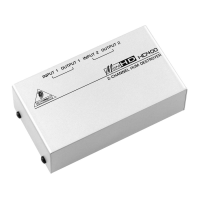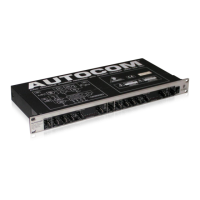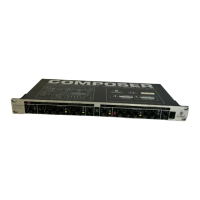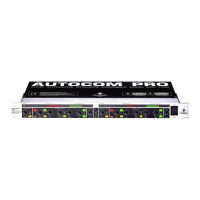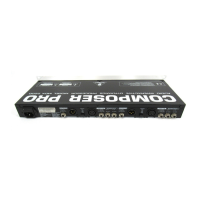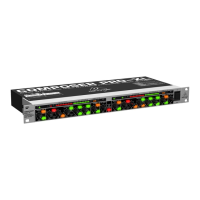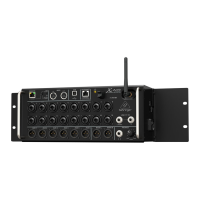10 MULTICOM PRO-XL MDX4600/PRO-XL MDX2600/AUTOCOM PRO-XL MDX1600 User Manual
Once you have checked the EQ setting, switch o SC MON and adjust the
THRESHOLD, so that the compressor responds to the interference signals only.
Control element Position
SC EXT switch IN
SC MON switch OUT
INTERACT KNEE switch OFF
LO CONTOUR switch OUT
THRESHOLD control +20 dB
RATIO control 4:1
AUTO switch OUT
ATTACK control 0.3 msec
RELEASE control 150 msec
OUTPUT control 0 dB
Tab. 3.1: Eliminating interference with an inserted equalizer (basic settings)
3.2 Emphasizing instruments
Conversely, you can also use your COMPOSER PRO-XL or AUTOCOM PRO-XL
to highlight solo instruments or vocal tracks acoustically in a less than
perfectrecording.
Please note that in this application only the amplitudes of the selected
frequencies should be reduced in level.
Compression produces a subjective volume reduction of the entire program
material. Only those frequencies selected on the equalizer will cause NO
compression and thus they seem to be emphasized acoustically. Thisinverse
type of compression helps you make instruments stand out even in
low-level passages.
3.3 Time-delayed compression
If you feed the audio signal directly into the SC RETURN input and at the same
time route it to the audio input via a delay unit, the dynamics processor will work
“anticipatorily”. With a bit of tweaking you can achieve “zero” attack eects for
specic frequencies. Longer delays produce an eect that is similar to an audio
tape being played back in reverse.
3.4 “Voice Over” compression (“Ducking”)
You can use the COMPOSER PRO-XL and AUTOCOM PRO-XL to lower music to a low
background level as soon as a speaker speaks into the microphone. In this type of
application the compressor section functions like an automatic fader controlled
by the speaker’s microphone, which is also connected to the SC RETURN input via
a preamplier. Music and microphone signal are then mixed with the help of a
console. This application is called “voice over” compression or “ducking”, and is
used frequently in discotheques or radio stations.
3.5 Triggering additional sounds from a
rhythm track
This technique is used to give a rhythm track more “punch” by synchronizing the
rhythm instruments after recording. Only the expander/gate section is required,
the compressor and/or peak limiter remain disabled. Insert the bass guitar track
into the audio path of the COMPOSER PRO-XL (or AUTOCOM PRO-XL), and route
the bass drum to the SC RETURN input. Activate the SC EXT function to trigger
the bass guitar with the kick drum, i.e. the kick drum exceeds the expander
threshold, allowing the bass guitar signal to pass until the level has dropped
below threshold again.
4. Wiring
Dynamics processors are usually inserted into the insert paths of a mixing
console, because their signals are not added to the mix (unlike reverb or phaser
eects, which are fed into the signal path via the aux busses).
Mixer
Return
Send
Out
COMPOSER PRO-XL MDX2600
In
Channel Insert
Fig. 4.1: Inserting a dynamics processor into the insert path
You can also insert the COMPOSER PRO-XL, MULTICOM PRO-XL or AUTOCOM
PRO-XL into a sub-group insert (miking of drums!) or to process the mix output
of the console (Main Out and/or Main Inserts). Here, too, the processor should be
inserted into an insert path, so that you can fade out the overall signal by closing
the main faders on the console.
COMPOSER PRO-XL MDX2600
DAT Recorder
Send
Mixer
L R
L R
Main Out Main Insert
Return Return
Send
Fig. 4.2: Compressing a main mix signal with the MDX2600
◊ When you process a stereo mix signal, we recommend that you link
the channels in couple mode, because there is no faster and easier
way to find the right settings. However, remember to set the output
levels separately!
If you wish to use the dynamics processor as part of a P.A. system integrating
an active frequency crossover (e.g. BEHRINGER SUPER-X PRO CX2310), youcan
connect it between the mixing console output and the crossover input,
orbetween the crossover and the power amps. In the latter conguration you
can process individual frequency ranges specically (multi-band compression)
toprevent a few high-energy frequencies triggering the compressor to process
the entire frequency range. The illustration below shows how to set up this
conguration with the BEHRINGER MULTICOM PRO-XL MDX4600.
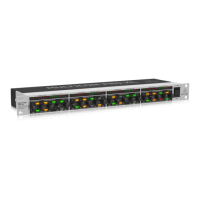
